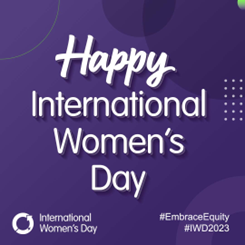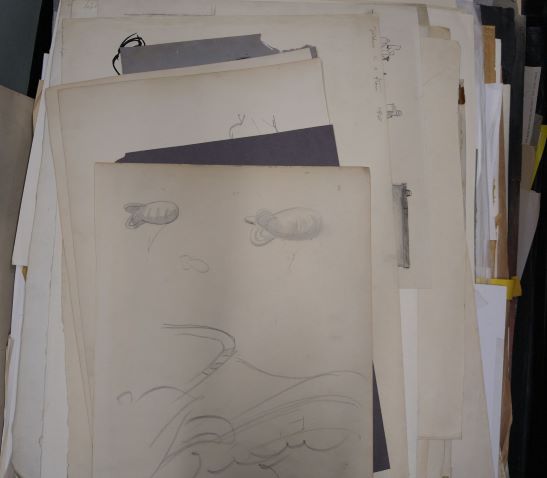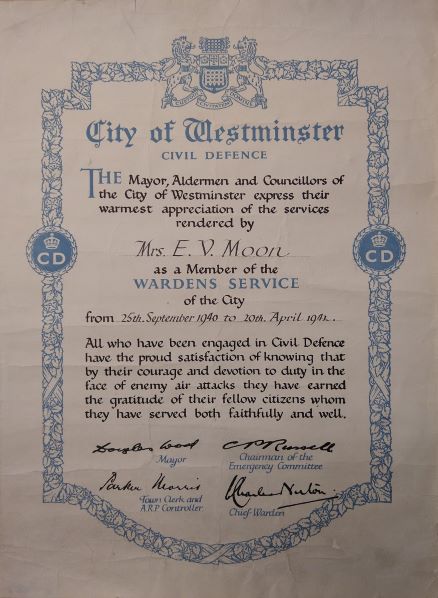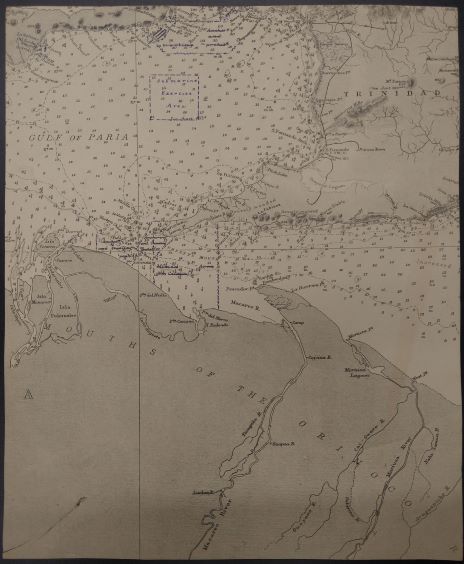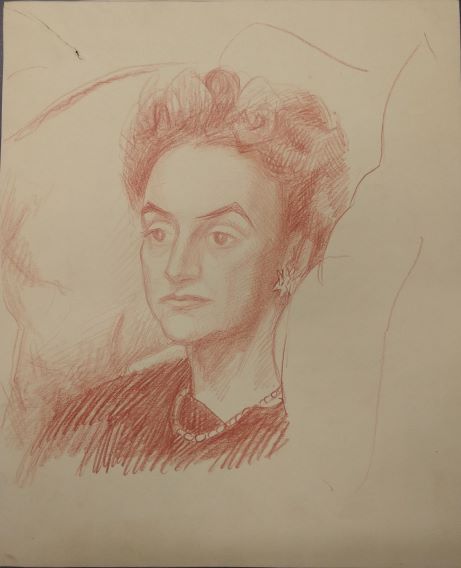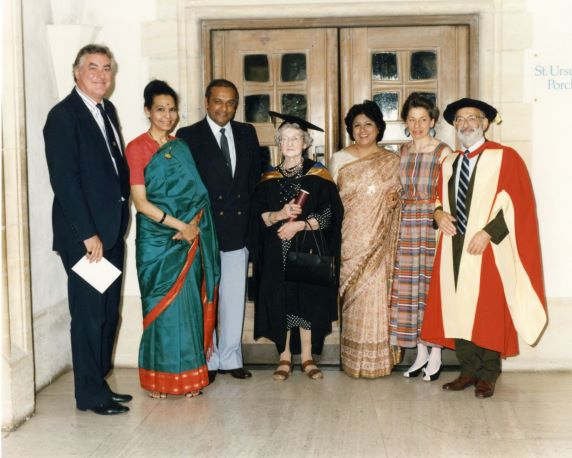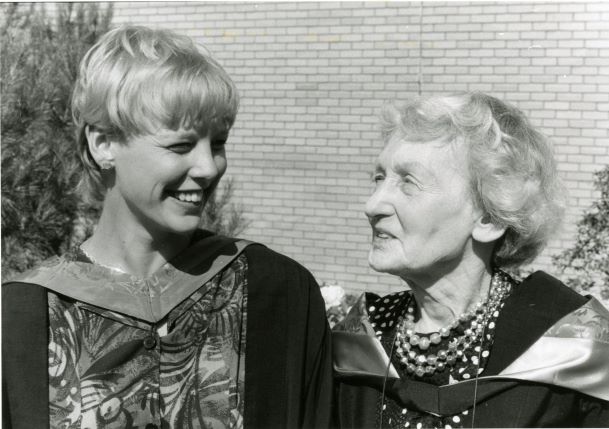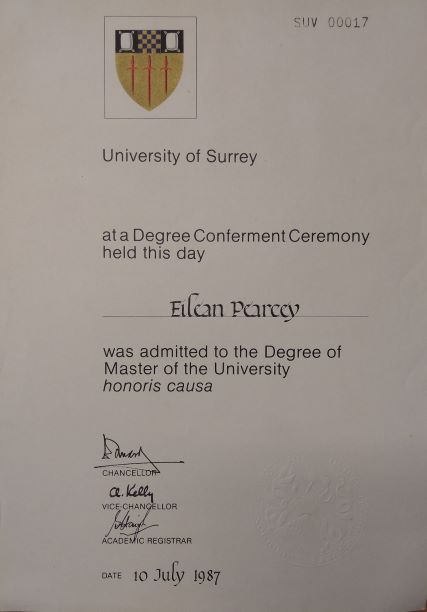The life and work of Eilean Pearcey
To celebrate this year’s International Women’s Day we have taken the opportunity to highlight the life and work of the artist Eilean Pearcey (1901–1999).
We are lucky that we hold both Eilean’s archive of papers and drawings, as well as artworks created by her that she donated to the University Art Collection. The wealth of information that is held within the collections will enable future researchers to look at this unique material and trace the influences and inspirations behind her art.
We could write multiple blogs about Eilean’s extensive and wide-ranging artistic output, but for now we have created two blogs, the first will explore key points in her life, illustrated by items from the archive collection. The second blog, which will be posted tomorrow, is written by our Art Collection Audit Officer David Wootton, and this will focus specifically on Eilean’s passion for Indian dance.
The archive collection comprises 26 portfolios, along with 11 boxes of drawings, 5 boxes of photographs, 6 boxes of journals and books, 2 boxes of diaries, 4 boxes of correspondence, 18 boxes of miscellaneous papers (including cuttings, flyers, notes, and manuscripts) and a box of printing blocks.
The material in the archive collection is uncatalogued, so unfortunately we are currently unable to make it available to researchers. Work is required to not only record the details of the items but to also undertake preventative conservation work and to repackage items to protect from potential damage through handling. However, we hope that by creating these blog posts we can share some of her work and offer insights into the collections.
As you would imagine the cataloguing and repacking of such a large amount of material is an extremely time-consuming task and not one that we have yet been able to undertake, so it was with sense of privilege and great enthusiasm that we carefully opened up some of the boxes and portfolios to take a look at her work.
So, who was Eilean Pearcey? Eilean was born in Melbourne, Australia in 1901 and as an undergraduate at Melbourne University she read both humanities and science. After obtaining her degree she then spent four years studying figure drawing and anatomy.
In 1928, she married engineer Allan Ramsay Moon. It was also around this time that an event pivotal to the direction of Eilean’s artistic career took place. During one of Anna Pavlova’s celebrated tours of Australia, Eilean had the opportunity to sit backstage and sketch the renowned ballerina in performance, and it was this experience that would inspire her to try to capture the essence of dancers in motion.
In 1931, Eilean and her husband left Australia and moved to London. Eilean continued to further her art studies in both London and Paris and spent time sketching dancers and performers from backstage vantage points. In January 1933, Eilean gave birth to a son, Felix.
In 1936, Eilean’s husband, who was a pioneer of Electric Arc Welding, was employed as a consultant on the construction of the Bank of England’s new Centre Court building. Eilean attended the site during its construction and sketched the scene. Etchings were made up from her sketches and it is believed that her work is the only record of the construction process.
Her first solo show in London was scheduled for the 15 October 1939 but the outbreak of World War II meant that it was unable to go ahead as planned. In 1940, her studio in London was bombed and it is currently unclear whether this took place whilst she was on duty as an air-raid warden or whether this event inspired her to volunteer. In time, further investigation of her papers may help to resolve this question.
In the collection we are fortunate to have Eilean’s Civil Defence Warden Certificate, that records her service from 25 September 1940 to 20 April 1942.
We also hold an artwork created by Eilean, along with several of her preliminary sketches, that evocatively depicts an air raid. The depiction of a woman on duty is particularly apt for International Women’s Day and it is possible that this individual could be a representation of Eilean herself. This is another query that may be solved with further investigation of the collection. Barrage balloons can be seen at the top of the artwork, and these are similar to the sketches which feature in the portfolio image that appears above. If you look closely, you can also see a small black cat in the bottom right-hand corner. It may only be a small element of the artwork but Eilean’s skill and aptitude for depicting the appearance of movement is clearly demonstrated.
After leaving the Civil Defence Service Eilean continued her war work and served in the Operations Division (Minelaying) in the Admiralty. In correspondence with the University regarding the award of her honorary master’s degree in 1987, Eilean provided a glimpse into the work she was involved in at the Admiralty:
‘From 1942 to 1944 I was in the Operations Division (Minelaying) Admiralty, Whitehall, and I wrote the Minelaying Diary, which was used for Post-War Mine Clearance; from 1945 to 1952, I was assistant to Captain H. H. McWilliam RN who was writing the Secret Naval History of Air Warfare Development.’ (Ref No P7/393/29)
In a letter of reference written by Captain J. S. Cowie dated 6 March 1946 Eilean’s work is described as follows:
‘The work involved was of a highly secret and complex nature, and I have no hesitation whatever in recommending Mrs Moon for a responsible position in which integrity, tact, capacity for detailed work, and a very high standard of education and intelligence are the primary requirements.’
Knowing of her work with the Royal Navy it is fascinating to find sketches in the collection that have been drawn on the back of cut down sea charts. In this example an area marked ‘Submarine Exercise Area’ can be seen in the top left-hand section.
In November 1945, Eilean’s son Felix became seriously ill and tragically died of meningitis aged 13. The devastating loss of her son was something she felt every day of her life.
In 1946, Eilean’s marriage was formally annulled and her ex-husband returned to Australia. Eilean occasionally travelled back to Australia, and we know she took trips to India and Nigeria, but she made London her home for the rest of her life.
Eilean developed a great interest in Indian dance and culture, including not just becoming a teacher of yoga but also producing drawings for yoga books, and our second blog will discuss this in further detail.
Eilean was fascinated by all types of dance and from her drawings and programme collection we can see that she attended London dance performances of Capoeira, Mexican, Korean, Latin American and Japanese Kabuki.
In 1968, an exhibition of Eilean’s work was exhibited at University of Surrey (whilst still at our Battersea site) which was the start of an ongoing relationship with the University. In 1973, there was a second exhibition of her paintings and drawings at the University which by this time had completed the move down to our Guildford campus. The exhibition comprised 59 artworks which featured a variety of subjects including a monks dance from South Korea, Ukrainian dancers, the mime artist Marcel Marceau, an African dancer and drummer, and Trafalgar Square at dusk.
In 1986, Eilean wrote to the University regarding donating a collection of her paintings and drawings. These were gratefully received and in 1987 the University of Surrey awarded her an honorary Master’s degree. In this photograph taken at St Ursula’s Porch in Guildford Cathedral on the day of the ceremony, 10 July 1987, Eilean can be seen in the centre along with her guests, John Drummond, Surya Kumari, Reginald Massey, Jamila Massey. Also pictured is Professor Lewis Elton.
On the same day as Eilean’s ceremony the first graduate of the University’s undergraduate degree in course in Dance Studies also received her award and this lovely photograph shows them both together.
Following Eilean’s death in 1999 her papers, diaries, correspondence and artwork were deposited in the National Resource Centre for Dance archives at the University of Surrey. Poignantly, these papers also included the honorary degree certificate she had been awarded 12 years before.

